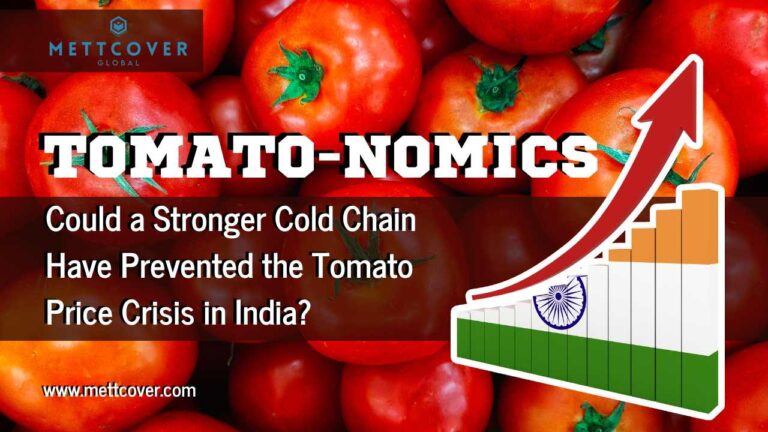Tomato-Nomics vs. India’s Cold Chain: Could a Stronger Cold Chain Have Prevented the Tomato Price Crisis in India?”
- Samantha Garcia

New Delhi, June 29, 2023 – India’s tomato prices have skyrocketed, thrusting consumers into a state of distress and intensifying concerns over rampant food inflation. This alarming surge in costs can be attributed to the abysmal failures within the Indian cold chain industry, disruptive supply chain inefficiencies and colossal crop losses. The abysmal per capita availability of tomatoes serves as a glaring reminder of how farm-to-fork cold chain management needs to be strengthened in India through cost-effective insulated packaging and localized community silos.
As the southwest monsoon season unfolded, hopes of relief from the scorching summer were dashed. The rainfall remained a staggering 16% below the long-term average, exposing the inadequacy of relying solely on erratic seasonal patterns to predict agricultural output and inflation. Tomato prices, already surging before the monsoon’s arrival, spiraled even higher due to a toxic blend of factors, including unusually high temperatures and devastating pest infestations that struck three months prior.
Staggering statistics lay bare the sheer magnitude of this cold chain crisis. An alarming 30% of fruits and vegetables cultivated in India, accounting for a mind-boggling 40 million tons and valued at a staggering US$13 billion, succumb to the cold chain chasm every year. The underlying culprits behind this egregious wastage are woefully inadequate infrastructure, abysmal storage capacity, and dilapidated transportation networks. The resultant price instability inflicts irreparable damage to farmers’ livelihoods and amplifies the grim specter of rural impoverishment, perpetuating the never-ending cycle of suffering within the farming community.
Adding insult to injury, the notorious El Nino phenomenon, characterized by abnormal warming of Pacific Ocean waters, looms ominously over India’s agricultural prospects. Studies conducted by the Reserve Bank of India (RBI) reveal that El Nino years typically spell doom for crop yields. Paddy, the staple crop of the kharif season, stands particularly vulnerable. This year’s delayed monsoon onset resulted in a distressing 35% decrease in paddy acreage compared to the previous year. Compounding the misery, the Government of India (GOI) currently grapples with the lowest rice stockpile levels in five years, with a meager 26.2 million tonnes to meet demand. Such depleted stocks fuel price expectations, and just recently, the weighted average market price of paddy arrivals shot up by a staggering 9% compared to last year.
In the face of this calamity, India’s cold chain infrastructure falls grotesquely short, failing to expand at a pace commensurate with escalating demands and the growing climate risks. The fundamental role of cold chains in mitigating wastage and tempering price volatility of perishable goods remains a distant dream, as the nation grapples with grossly inadequate cold storage facilities, especially at the grassroots level. This erroneous oversight continues to perpetuate nightmarish post-harvest losses and aggravate price fluctuations.
Averting this catastrophic trajectory demands urgent action. The establishment of a cost-effective and localized model of farm-gate storage must become an immediate priority, with a focus on deploying cold rooms and small-scale cold-chain localized cold chain systems. These vital storage facilities must be strategically positioned in rural areas to cater to local horticultural farmers and must deploy cost effective thermal insulated covers. In addition, an element of active cold chain, powered by sustainable solar energy and tailored to suit the economic constraints of small and marginal farmers is imperative to the mission’s success. Local cold rooms would serve as localized bastions of storage. Subsequently, the produce safeguarded within these cold rooms can be transported to final marketplaces through a well-connected network of small cold-chain reefer vans. Such a comprehensive mechanism, overseen by state agricultural marketing boards and the Warehousing Development and Regulatory Authority, holds the potential to drastically curtail post-harvest losses and offer a glimmer of hope for farmers’ income prospects.
Additionally, an urgent need exists for centralized monitoring and real-time data tracking, encompassing availability, capacity utilization, and associated costs. A failure to maintain and share critical information regarding India’s cold storage infrastructure is a grave oversight, resulting in avoidable wastage and irreparably compromising the system’s overall efficiency.
In the current tomato pricing crisis, Indian cold chain industry’s abysmal performance assumes center stage in the spiraling tomato price crisis, perpetuating the country’s chronic food inflation. Swift and resolute action is imperative to establish an end-to-end cold-chain infrastructure, capable of tackling supply-side shortages stemming from wastage, empowering farmers, and effectively mitigating the volatile fluctuations in fruit and vegetable prices. Only through embracing localized storage solutions and bolstering monitoring systems can India surmount the colossal challenges posed by post-harvest losses, fostering a more sustainable agricultural ecosystem that provides respite to both farmers and consumers alike.
Disclaimer: The opinions expressed in this article are those of the author and do not, in any which way, reflect the views and opinions of Mettcover Global. As a publisher of this news piece, Mettcover Global and all of its subsidiaries/affiliates have not verified the information & statistics given in this news article; AND cannot be held liable for any wrong information published. If you have any concerns regarding the contents of this article, please report it at info@mettcover.com.




